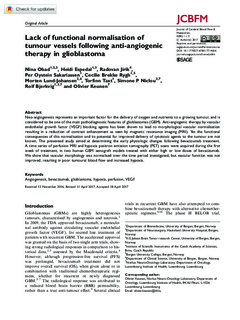| dc.contributor.author | Obad, Nina | |
| dc.contributor.author | Espedal, Heidi | |
| dc.contributor.author | Jirík, Radovan | |
| dc.contributor.author | Sakariassen, Per Øystein | |
| dc.contributor.author | Rygh, Cecilie Brekke | |
| dc.contributor.author | Lund-Johansen, Morten | |
| dc.contributor.author | Taxt, Torfinn | |
| dc.contributor.author | Niclou, Simone Pierrette | |
| dc.contributor.author | Bjerkvig, Rolf | |
| dc.contributor.author | Keunen, Olivier | |
| dc.date.accessioned | 2019-03-15T10:07:03Z | |
| dc.date.available | 2019-03-15T10:07:03Z | |
| dc.date.created | 2018-02-20T13:54:19Z | |
| dc.date.issued | 2017 | |
| dc.identifier.citation | Obad, N., Espedal, H., Jirik, R., Sakariassen, P. O., Brekke Rygh, C., Lund-Johansen, M., . . . Keunen, O. (2017). Lack of functional normalisation of tumour vessels following anti-angiogenic therapy in glioblastoma. Journal of Cerebral Blood Flow & Metabolism, 38(10), 1741-1753. | nb_NO |
| dc.identifier.issn | 0271-678X | |
| dc.identifier.uri | http://hdl.handle.net/11250/2590197 | |
| dc.description.abstract | Neo-angiogenesis represents an important factor for the delivery of oxygen and nutrients to a growing tumour, and is considered to be one of the main pathodiagnostic features of glioblastomas (GBM). Anti-angiogenic therapy by vascular endothelial growth factor (VEGF) blocking agents has been shown to lead to morphological vascular normalisation resulting in a reduction of contrast enhancement as seen by magnetic resonance imaging (MRI). Yet the functional consequences of this normalisation and its potential for improved delivery of cytotoxic agents to the tumour are not known. The presented study aimed at determining the early physiologic changes following bevacizumab treatment. A time series of perfusion MRI and hypoxia positron emission tomography (PET) scans were acquired during the first week of treatment, in two human GBM xenograft models treated with either high or low doses of bevacizumab. We show that vascular morphology was normalised over the time period investigated, but vascular function was not improved, resulting in poor tumoural blood flow and increased hypoxia. | nb_NO |
| dc.language.iso | eng | nb_NO |
| dc.publisher | SAGE Publications | nb_NO |
| dc.rights | Navngivelse-Ikkekommersiell 4.0 Internasjonal | * |
| dc.rights.uri | http://creativecommons.org/licenses/by-nc/4.0/deed.no | * |
| dc.subject | Angiogenesis | nb_NO |
| dc.subject | bevacizumab | nb_NO |
| dc.subject | glioblastoma | nb_NO |
| dc.subject | hypoxia | nb_NO |
| dc.subject | perfusion | nb_NO |
| dc.subject | VEGF | nb_NO |
| dc.title | Lack of functional normalisation of blood vessels following anti-angiogenic therapy in glioblastoma | nb_NO |
| dc.type | Journal article | nb_NO |
| dc.type | Peer reviewed | nb_NO |
| dc.description.version | publishedVersion | nb_NO |
| dc.rights.holder | © Author(s) 2017 | nb_NO |
| dc.subject.nsi | VDP::Medisinske Fag: 700::Basale medisinske, odontologiske og veterinærmedisinske fag: 710 | nb_NO |
| dc.subject.nsi | VDP::Medisinske Fag: 700::Klinisk medisinske fag: 750::Onkologi: 762 | nb_NO |
| dc.source.pagenumber | 1741-1753 | nb_NO |
| dc.source.volume | 38 | nb_NO |
| dc.source.journal | Journal of Cerebral Blood Flow and Metabolism | nb_NO |
| dc.source.issue | 10 | nb_NO |
| dc.identifier.doi | 10.1177/0271678X17714656 | |
| dc.identifier.cristin | 1567023 | |
| cristin.unitcode | 203,3,0,0 | |
| cristin.unitname | Avdeling for helse- og sosialfag - Bergen | |
| cristin.ispublished | true | |
| cristin.fulltext | original | |
| cristin.qualitycode | 2 | |

